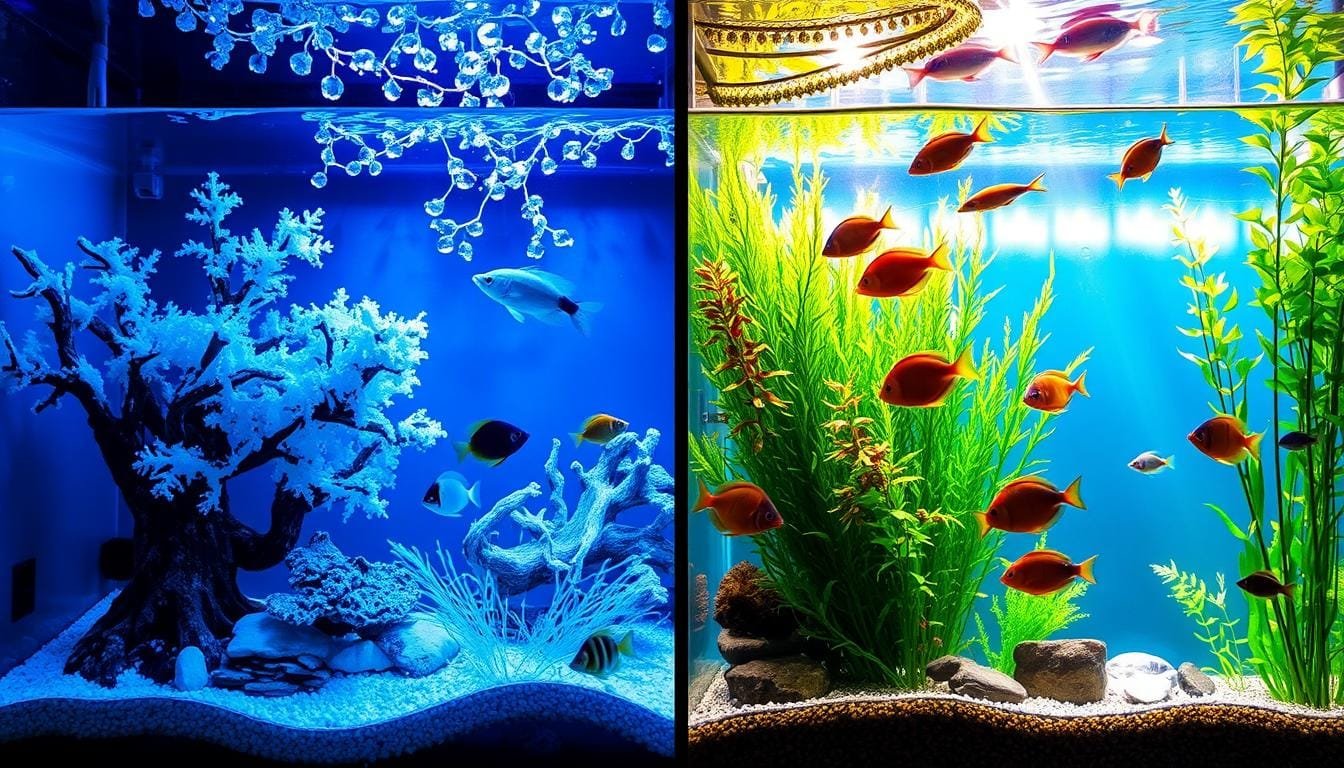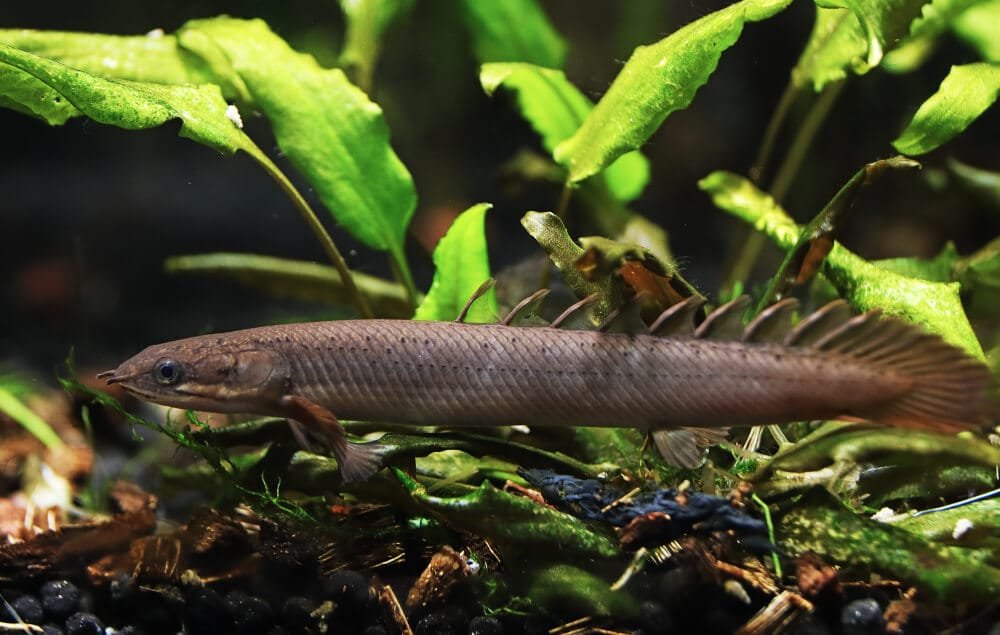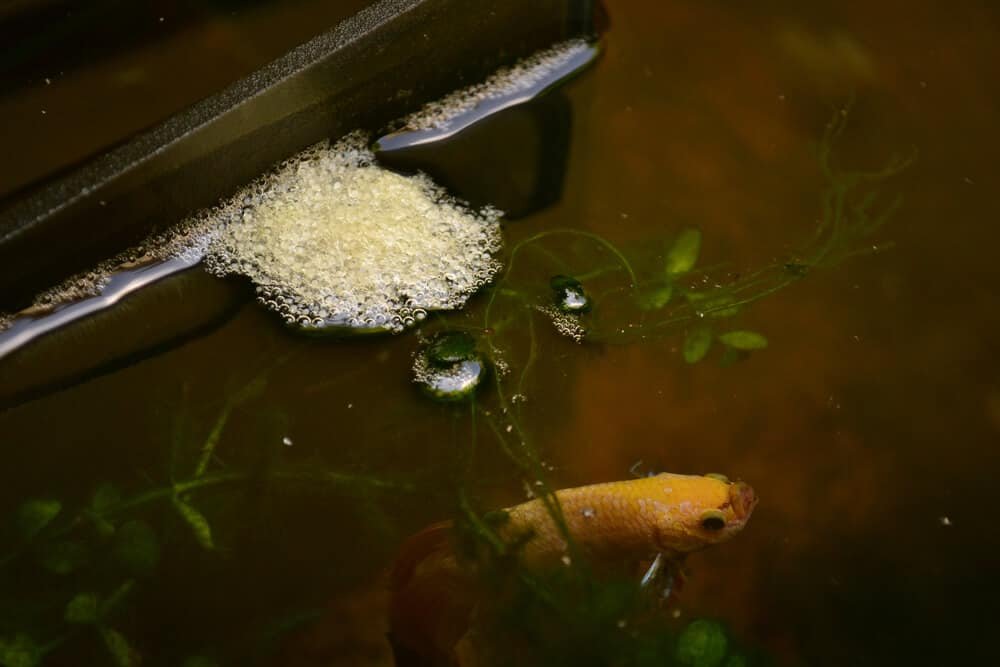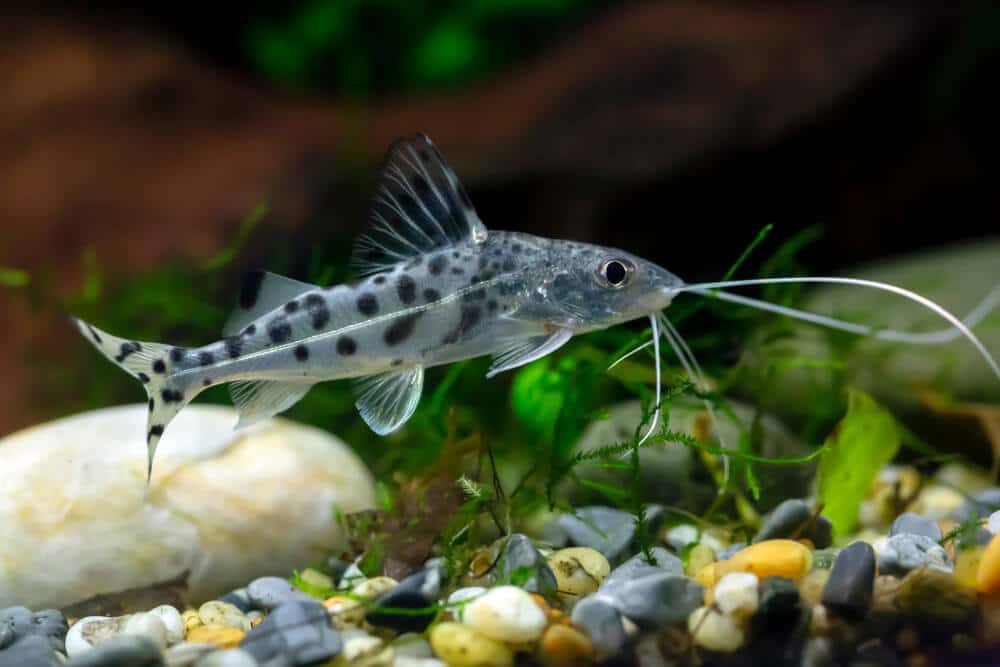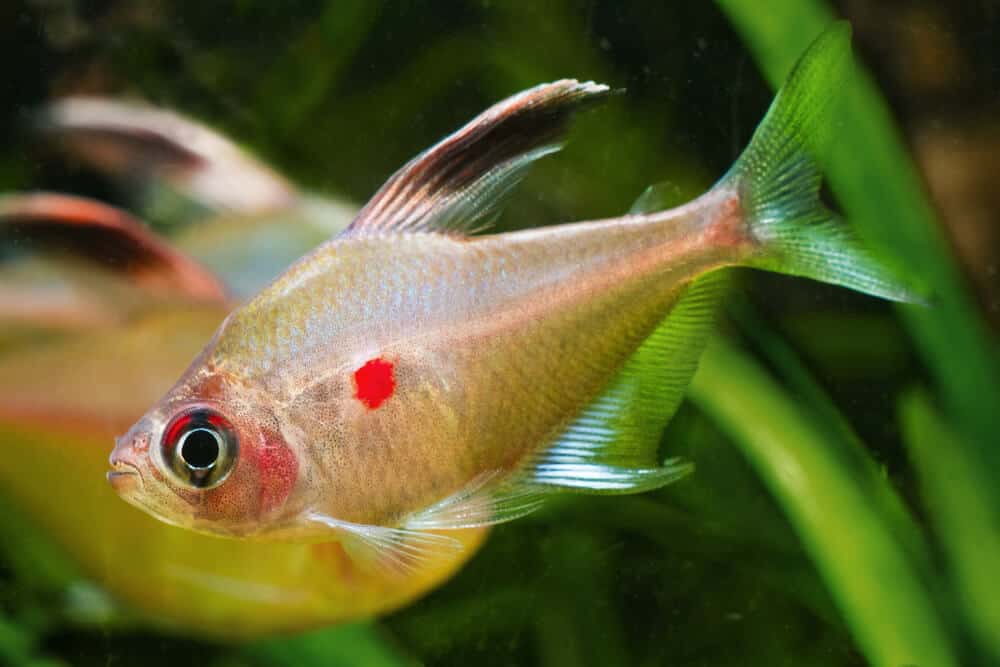Seasons affect your aquarium and its inhabitants. Temperature changes impact fish health, water conditions, and maintenance. Aquarium owners must adapt their care routines throughout the year.
Each season brings unique challenges for aquarium upkeep. Spring calls for deep cleans. Summer requires temperature control measures. These steps ensure a thriving aquatic environment.
Fish activity and feeding habits change with seasons. In spring, warmer water increases fish energy and appetite. Some species may focus on mating behaviors during breeding season.
Summer’s warm water leads to increased fish feeding. Fish may eat more insects and algae. Be careful not to overfeed, as it can cause water quality issues.
Autumn brings cooler temperatures and decreased fish appetite. Monitor water temperature to adjust feeding frequency. Winter requires stable water temperatures to prevent freezing.
Seasonal care involves more than feeding and temperature control. Regular water changes and filter maintenance are crucial. Algae control and lighting adjustments also contribute to a healthy aquarium.
The Importance of Seasonal Aquarium Maintenance
Seasons affect your aquarium’s ecosystem. Temperature and lighting changes impact fish and plants. Adapting your maintenance routines is crucial for their health.
Understanding the Impact of Temperature Changes
Temperature shifts challenge aquarium owners during seasonal transitions. Most tropical fish thrive in 75°F to 86°F (24°C to 30°C) water. Maintaining this range can be tough as ambient temperatures change.
Fish are sensitive to quick temperature changes. This can stress them and weaken their immune systems. It makes them more prone to diseases.
Summer’s warmer water holds less oxygen. This requires more aeration for fish. Higher temps can also speed up algae and bacteria growth.
Winter’s lower temps slow fish metabolism. This affects their appetite and activity. You may need to adjust feeding and use aquarium heaters.
Adapting to Seasonal Shifts in Water Chemistry
Seasons also affect aquarium water chemistry. Summer increases evaporation, causing dissolved solids buildup. Winter reduces evaporation, diluting essential minerals. Regular monitoring helps maintain optimal conditions.
Here are tips to adapt to seasonal changes:
- Perform regular water tests to monitor pH, ammonia, nitrite, and nitrate levels, especially during summer when increased biological activity can quickly alter water parameters.
- Adjust water change frequencies based on the season and your aquarium’s specific needs. Experts recommend changing 20% of the water weekly or every other week, depending on fish population and waste production.
- Use beneficial bacteria supplements, such as OZPOLISH Bio-Cure, to support the nitrogen cycle and maintain biological stability despite temperature fluctuations.
- Adapt your filtration system to handle the increased bioload during summer months, and consider adding additional aeration to improve oxygen levels in the water.
Understanding seasonal impacts helps create a stable aquarium environment. Regular monitoring and proactive adjustments are key. Consistent care ensures your aquatic ecosystem’s long-term health and beauty.
Spring Aquarium Care: A Fresh Start
Spring is here, and it’s time to refresh your aquarium. This involves cleaning, equipment checks, and adjusting feeding schedules. These steps ensure your fish thrive in changing conditions.
Performing a Deep Clean
Remove and clean all aquarium decorations, like rocks and driftwood. Soak plants in 5% bleach to kill algae and pests. Avoid this for stem plants.
Vacuum the substrate to remove debris. Be careful not to remove more than 50% of the water. This helps maintain the tank’s ecosystem.

Checking and Maintaining Equipment
Check your heater, filter, and other equipment for proper function. Clean or replace parts as needed. Consider having a backup heater to prevent temperature drops.
Replace filter media with carbon or ion-exchange resins every three weeks. This maintains optimal water hardness and quality in your freshwater aquarium or saltwater aquarium.
Monitoring Water Parameters
As temperatures rise, watch your aquarium’s water parameters closely. Fish metabolism increases, affecting oxygen levels and waste production. Conduct regular water tests and adjust your maintenance routine.
| Parameter | Ideal Range | Testing Frequency |
|---|---|---|
| Temperature | 75-80°F (24-27°C) | Daily |
| pH | 6.5-7.5 | Weekly |
| Ammonia | 0 ppm | Weekly |
| Nitrite | 0 ppm | Weekly |
| Nitrate | <40 ppm | Monthly |
Adjusting Feeding Routines
As fish metabolism increases, adjust your feeding schedule. Offer a varied diet to support their health. Be careful not to overfeed, as this can harm water quality.
Consider joining aquarium groups for education and support. About 60-75% of aquarists participate in such communities.
Regular observation is necessary, as 90% of stress indications in fish are linked to behavior changes.
Follow these spring aquarium care tips for a healthy environment. Your aquatic pets will thrive with proper care and attention. Remember to check your feeding schedule regularly.
Summer Aquarium Care: Beating the Heat
Hot summers can stress your aquarium’s ecosystem. High temperatures lower oxygen levels, harming aquatic life. Proper care is crucial for your fish tank setup.
Temperature control, frequent water changes, and better aeration are key. These steps keep your aquarium healthy during hot months.
Implementing Temperature Control Measures
Monitoring water temperature is vital in summer aquarium care. Most tropical fish thrive between 65°F to 85°F (18°C to 30°C).
A 15°F rise can double fish respiration, causing stress. Aim for 75°F to 80°F for most species.
- Monitor tank temperature closely, aiming for a stable range between 75°F to 80°F for most species.
- Use aquarium chillers or fans to help regulate water temperature, especially in rooms prone to heat buildup.
- Replace incandescent bulbs with LED lighting, as they generate significantly less heat.
- Position your aquarium away from direct sunlight and heat sources to minimize temperature spikes.
Increasing Water Change Frequency
Summer demands more frequent water changes. Warm water holds less oxygen, affecting fish health. Regular changes replenish oxygen and remove waste.
Change 25-30% of tank water weekly. Use a gravel vacuum to clean the substrate.
- Increase water change frequency to at least once a week, replacing 25% to 30% of the tank water.
- Use a gravel vacuum to remove debris and uneaten food from the substrate, preventing decay and oxygen depletion.
- Monitor water parameters closely, especially ammonia, nitrite, and nitrate levels, to ensure a healthy aquarium cycling process.
| Tank Size | Recommended Heater Wattage |
|---|---|
| 10 gallons | Two 20-watt heaters |
| 35 gallons | Two 50-watt heaters |
| 65 gallons | Two 75-watt heaters |
| 100 gallons | Two 100-watt heaters |
Enhancing Aeration and Circulation
Rising temperatures reduce water’s oxygen-carrying capacity. Boost aeration and circulation to maintain proper oxygenation. This helps keep your aquarium healthy.
- Install an air stone or bubble wall to increase surface agitation and gas exchange.
- Use a powerhead or wavemaker to create gentle water currents, promoting circulation and oxygenation.
- Ensure your filter output is positioned to create surface movement, enhancing oxygen diffusion.
- Avoid overfeeding, as excess food can lead to waste buildup and oxygen depletion.
A study indicated that when the water temperature dropped to 57°F (14°C), only 20% of the corydoras fish perished, highlighting their adaptability to temperature fluctuations.
These strategies help your aquatic pets thrive in hot months. A well-maintained biofiltration system and regular care ensure a healthy aquarium.
Proper temperature control and water changes support a vibrant underwater world. Your fish will enjoy a smooth seasonal transition with these practices.
Fall Aquarium Care: Preparing for Cooler Months
Fall is a crucial time for aquarium maintenance. It sets the stage for a healthy tank throughout winter. Proper tank cleaning, heater checks, and stable temperatures are key to fish health.
Taking proactive steps now helps your fish adapt to seasonal changes. Your aquatic friends will thrive with the right care.
Ensuring Proper Heater Functionality
Check your heater for wear or malfunction as temperatures drop. Your heater will work harder to maintain stable water temps.
Consider getting a backup heater to prevent unexpected failures. Sudden temperature drops can stress fish and cause illness.
Maintaining Stable Water Temperature
There are several ways to keep water temperatures stable in fall. Here are some helpful tips:
- Reduce the amount of light your tank receives to mimic natural seasonal changes
- Monitor water temperatures closely and adjust your heater settings as needed
- Avoid placing your aquarium near drafty windows or doors
- Insulate your aquarium to help retain heat and prevent temperature fluctuations
Do a thorough health check on your fish before winter. Healthy fish handle stress better during cooler months.
Keep an eye on your fish during this time. Look for signs of illness or unusual behavior.
| Water Temperature | Feeding Recommendations |
|---|---|
| Below 70°F | Transition to a wheat germ base mixed with staple food |
| 60°F | Feed exclusively wheat germ-based foods |
| 55°F | Fish metabolism slows, decrease food intake |
| Below 50°F | Stop feeding until spring |
Pay close attention to your aquarium’s needs during fall. This ensures a smooth transition into winter and a thriving tank.
Extra care now promotes long-term health for your aquatic companions. Your fish will thank you with their vibrant colors and active behavior.
Winter Aquarium Care: Keeping Your Tank Warm and Healthy
Cold winters require extra care for your aquarium. Your fish need a warm, stable environment to stay healthy. Here are some key strategies to keep your aquatic pets comfortable during chilly months.
Insulating Your Aquarium
Insulation is vital for keeping your aquarium warm in winter. Place your tank in a warmer room or add a background. Avoid drafty windows or doors to prevent temperature changes that can stress your fish.
Monitoring Heater Performance
A reliable aquarium heater maintains consistent water temperature in winter. Most tropical fish thrive in 24°C to 28°C (75°F to 82°F). Check water temperature often with a thermometer.
For tanks over 50 gallons, use two heaters for even heat. Replace heaters every 2-3 years for best performance.
| Tank Size (Gallons) | Recommended Heater Wattage |
|---|---|
| 10 | 50 watts |
| 20 | 75-100 watts |
| 30 | 100-150 watts |
| 40 | 150 watts |
| 50 | 200 watts |
Adjusting Lighting and Feeding Schedules
Fish metabolism slows in winter, so adjust their seasonal feeding schedule. Feed 2-4 times daily above 12°C (54°F). Reduce to once daily during hibernation. Avoid overfeeding to maintain good water quality.
Adjust lighting to mimic natural winter daylight. Reduce aquarium light time to maintain healthy fish circadian rhythms. This helps your fish adapt to seasonal changes.
Perform regular water test kits and maintain your aquarium filtration system. Use equipment like an UV sterilizer to keep your aquarium thriving. These steps ensure optimal water quality throughout the colder months.
Seasonal Aquarium Care: Tips for Year-Round Success
Consistent care is crucial for a healthy aquarium all year. Follow these tips to help your fish thrive in every season. Tank monitoring, maintenance routines, and seasonal adjustments are key to aquarium success.
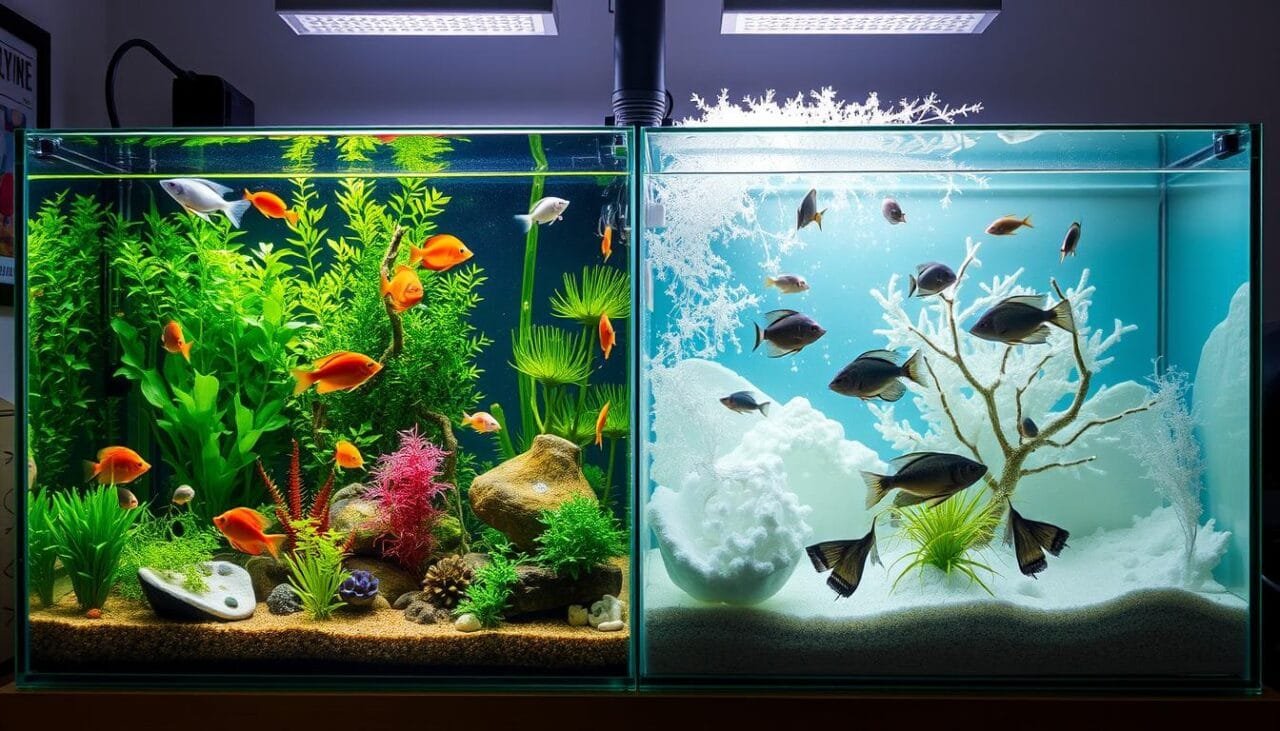
Regular water testing is essential for a healthy fish environment. Check aquarium pH levels, nitrate control, and phosphate control often. Here are some important points to remember:
- Tropical fish generally require water temperatures of 75-80°F, while coldwater fish prefer temperatures below 70°F.
- Marine fish thrive in a specific gravity range of 1.020-1.025 for optimal salinity levels.
- A 29-gallon aquarium can comfortably accommodate up to 30 inches of fish, following the general guideline of 1 inch of fish per gallon.
Watch your fish for signs of fish tank stress or illness. Unusual swimming, loss of appetite, or injuries may indicate problems. Quick action can prevent disease spread in your aquarium.
| Tank Type | Surface Area per Inch of Fish |
|---|---|
| Freshwater | 12 square inches |
| Coldwater | 30 square inches |
| Marine | 48 square inches |
Connect with other aquarium owners for valuable insights. Local groups and online forums can help you tackle seasonal challenges. Learn new strategies to keep your aquarium thriving year-round.
Experts recommend that the size of an aquarium should be based on the adult size of the fish rather than their size at the time of purchase.
Consistency is vital in aquarium care. Regular water changes, filter maintenance, and balanced feeding keep your tank healthy. Stay proactive and adapt to seasonal changes for a stable environment.
Your aquatic companions will flourish with proper care. Create a nurturing home for them in every season.
The Role of Regular Water Testing in Seasonal Aquarium Care
Regular water testing is vital for a healthy aquarium. It ensures optimal water clarity and supports biological filtration. Testing also prevents fish diseases and maintains stable temperatures.
Consistent water testing creates a safe environment for aquatic pets. It helps you catch problems early and take action quickly.
Importance of Monitoring Water Parameters
Poor water quality is the top killer of aquarium fish. Key factors to monitor include pH, ammonia, nitrite, and nitrate. Other important parameters are water hardness, chlorine, alkalinity, and salinity.
Regular testing helps detect imbalances early. This allows you to take quick action to protect your fish.
Recommended Water Testing Frequency
Testing frequency depends on your aquarium’s age, fish population, and recent changes. For established tanks, test monthly and before water changes.
New aquarium owners should test more often. This helps them learn their tank’s needs.
- For established aquariums, test water at least once a month and before routine water changes.
- Beginner aquarists should test water quality more frequently as they learn to gauge their tank’s needs.
- Increase testing frequency after adding new fish, observing signs of illness, or experiencing environmental changes like increased sunlight exposure in summer.
- For new aquariums, test water daily until safe and repeatable results are observed, then gradually decrease frequency to every three days, once a week, and eventually once a month.
Interpreting Test Results and Taking Corrective Actions
Know the ideal ranges for water parameters to keep a healthy aquarium. Ammonia and nitrite should be 0 ppm. Nitrate should stay below 50 ppm for fish safety.
For freshwater fish, pH levels should be between 6.5 and 8.0. Marine aquariums need salinity between 29 and 37 ppt.
Take action when test results are off. This may include water changes or adjusting filtration. Prompt action maintains a stable environment for your aquatic pets year-round.
Adapting Aquarium Lighting to Seasonal Changes
Seasonal changes affect your aquarium’s lighting needs. Natural light shifts impact your aquatic ecosystem’s health. Adjusting artificial lighting helps maintain optimal fish tank care.
Proper lighting prevents common aquarium issues. It ensures the well-being of your aquatic life. Understanding seasonal effects is crucial for successful aquarium management.
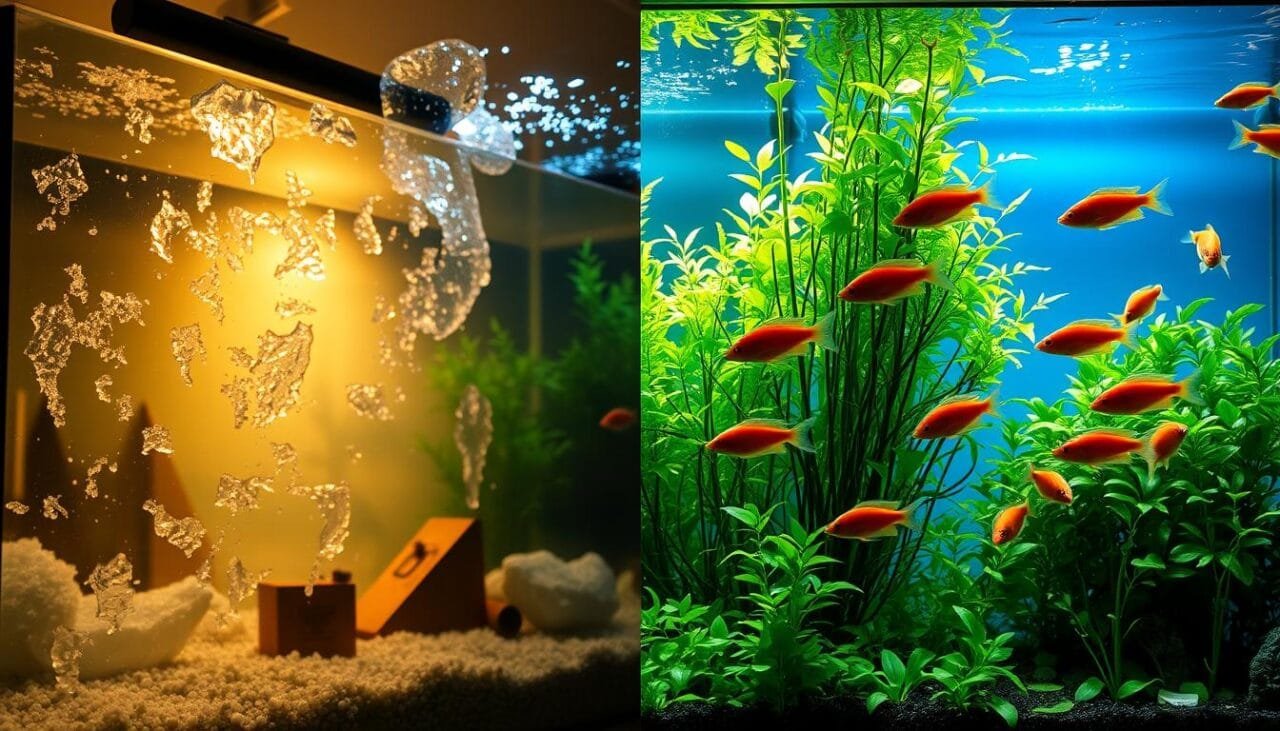
Understanding the Impact of Natural Light Fluctuations
Seasonal light changes influence your aquarium’s lighting needs. Winter’s shorter days may require more artificial light. This maintains a consistent 10-12 hour light cycle for fish and plants.
Summer’s excess natural light can cause algae overgrowth. Adjusting artificial lighting prevents water condition imbalances. Proper lighting management is key to aquarium health.
Consider these key points when adapting your aquarium lighting to seasonal changes:
- Most aquariums require between 8 to 12 hours of light each day, with 10 hours being a recommended starting point.
- Live aquatic plants require up to 12 hours of light per day for optimal photosynthesis.
- Tropical plants, such as banana, Amazon, Java, and water fern, thrive on roughly 12 hours of light each day throughout the year.
- Cold-water plants, like Anubias and tiger lotus, adapt better to seasonal variations in light levels.
Adjusting Artificial Lighting Schedules
Adjust artificial lighting schedules as seasons change. This maintains a thriving aquatic ecosystem. Supplement with artificial light even with ambient lighting present.
Increase artificial lighting duration in winter. This compensates for reduced natural light exposure. Monitor your aquarium’s response to lighting changes.
When adjusting your artificial lighting schedules, keep the following in mind:
| Lighting Type | Characteristics | Considerations |
|---|---|---|
| Incandescent, VHO-fluorescent, Metal Halide | Produce significant heat | Can drastically increase water temperatures; require constant temperature monitoring |
| Standard Fluorescent | Produce cooler light; affordable operation | Suitable for prolonged use in most aquariums |
| LED (Light Emitting Diode) | Energy-efficient; cool operation; various color options | Versatile and adaptable to different aquarium setups |
Monitor algae levels regularly. Excessive growth may indicate too much light exposure. Reduce light to 8 hours or less to control algae.
Be mindful of direct sunlight. It can cause more algae growth than artificial light. Adjust your lighting setup accordingly.
Proper lighting management ensures a healthy aquatic ecosystem. Combine it with good substrate management and regular care. This approach contributes to long-term aquarium success.
Seasonal Considerations for Aquarium Plants and Decor
Adapting your aquarium care routine is crucial as seasons change. This ensures the health of your aquatic plants and decor. Understanding seasonal shifts helps maintain a thriving ecosystem year-round.
Maintaining Healthy Plant Growth Throughout the Year
Aquatic plants are vital for nutrient cycling and biodiversity in aquariums. They provide habitat for various species and help with oxygenation. To keep plants healthy year-round, consider these factors:
- Light intensity and duration: Effective photosynthesis occurs in blue and red light spectrum. Tropical aquatic plants need up to 8 hours of light. Adjust lighting schedules to avoid algae blooms.
- Nutrient availability: Replenish macro and micro nutrients regularly. These include nitrogen, potassium, phosphorus, iron, and manganese. Tailor fertilization to plant species and tank size.
- Substrate depth: Keep substrate layer 5-7 cm thick. Use thicker layers for root-feeding plants. This supports nutrient uptake and overall plant health.
Monitor and adjust these factors throughout the year. This ensures your aquatic plants thrive in every season. Temperature also plays a significant role in aquatic life.
Most tropical plants and fish thrive in 24-28 degrees Celsius. Maintain this range for a healthy aquarium environment.
Adapting Decor to Seasonal Conditions
Seasonal changes in temperature and light can impact your aquarium decor. Summer warmth may promote algae growth. Winter’s reduced light can slow plant growth. To adapt your decor:
- Remove heat-trapping decorations in summer. This improves water circulation and prevents temperature fluctuations. It also reduces stress on fish and algae growth.
- Add insulation to your aquarium in winter. This maintains stable water temperatures and minimizes heat loss. It ensures a comfortable environment for aquatic inhabitants.
- Adjust artificial lighting to mimic natural seasonal changes. This promotes healthy plant growth and regulates fish behavior.
Adapting your aquarium decor creates a stable, appealing environment. This promotes the health of your aquatic plants and animals. It ensures they thrive year-round.
| Tank Parameter | Recommended Value | Seasonal Considerations |
|---|---|---|
| Temperature | 24-28°C (75-82°F) | Maintain stable temperature; avoid fluctuations |
| Light Duration | 8 hours (tropical plants) | Adjust based on seasonal light changes |
| Substrate Depth | 5-7 cm | Maintain consistent depth; replenish nutrients |
| Water Changes | Weekly; 1/3 tank volume | Increase frequency in summer; maintain consistency |
Consider seasonal factors and adapt your aquarium care routine. This maintains a thriving, stunning aquatic environment. Your aquarium will showcase nature’s beauty all year long.
Conclusion
Keeping a thriving aquarium requires attention to seasonal changes. You must adjust your care to ensure your aquatic pets’ well-being. Monitor tank water parameters and adapt to each season’s unique challenges.
Seasonal adjustments include water changes, filtration maintenance, and lighting modifications. These are crucial for a balanced ecosystem. Proper fish acclimation is vital when introducing new species or adapting to seasonal shifts.
Aquarium oxygenation supports fish growth and health, especially during warmer months. Aeration systems and good water circulation help counter high temperatures. These steps promote a healthy environment for your aquatic pets.
Millions of households worldwide enjoy the beauty of aquatic life. Understanding your fish and plants’ needs helps create a thriving aquatic environment. Regular maintenance and willingness to learn ensure long-term success.
Embrace the challenges and rewards of seasonal aquarium care. Enjoy the wonders of the underwater world in your home. Take your aquarium care further by simulating rainy seasons to trigger natural breeding behaviors.
Establish a proper feeding schedule for optimal fish health. This also prevents water quality issues. Stay informed and proactive to create a stunning underwater ecosystem.
FAQ
How often should I perform water changes in my aquarium during different seasons?
Water change frequency depends on your aquarium’s size, stocking level, and filtration. Do a 10-15% change every week or two. In summer, change water more often to manage temperatures and quality.
In winter, be careful with water temperature during changes. This helps avoid stressing your fish.
What should I do to prepare my aquarium for summer?
Use fans or chillers to keep temperatures between 75-80°F (24-27°C). Change water more often to manage rising temps and maintain quality. Add air stones or surface agitation for proper oxygen levels.
How can I maintain a stable water temperature in my aquarium during winter?
Check your heater works well and consider a backup. Insulate your tank with a background or move it to a warmer room. Monitor water temperature often and adjust the heater as needed.
Should I adjust my aquarium lighting schedule throughout the year?
Yes, mimic seasonal changes for your fish and plants. In winter, increase artificial lighting to 10-12 hours daily. In summer, watch out for excess natural light that can cause algae growth.
How often should I test my aquarium water, and what parameters should I monitor?
Test your water weekly or bi-weekly, depending on your aquarium’s needs. Monitor pH, ammonia, nitrite, and nitrate levels. Tracking these helps you spot and fix imbalances quickly.
What seasonal considerations should I keep in mind for my aquarium plants?
Seasons affect plant growth and health. Winter’s reduced light and lower temps may slow growth. Adjust lighting and fertilization as needed. Summer’s increased light can cause algae blooms.
Prune and maintain more often in summer. Adapt your plant care to the changing seasons.
How can I prevent temperature fluctuations in my aquarium during seasonal transitions?
Check your aquarium temperature daily with a good thermometer. Adjust heater settings slowly to avoid sudden changes. Use a chiller or fans in summer for stable temps.
In winter, keep your tank away from drafts and extreme temperature changes.
What should I do if I notice signs of stress or illness in my fish during seasonal changes?
Act fast if you see stressed or sick fish. Test water for pH, ammonia, nitrite, and nitrate imbalances. Do a partial water change to improve quality.
Adjust temperature gradually if needed. Consider moving affected fish to a quarantine tank. Ask an expert or vet for help treating specific illnesses.
